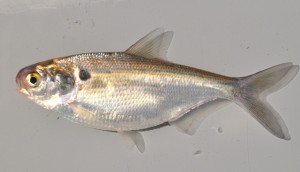A lot of talk at this time of year is about shad behavior and how that translates into catching more bass. We’re going to keep it fairly simple so that we don’t overload you with information that isn’t necessary.
To begin with, you have to determine what type of shad you’re dealing with at your favorite fishing hole. Is it threadfin shad, gizzard shad, blue-back herring or some other of the many species found in North America? Once you get this one figured out, there are several things that you can be looking for that should help you isolate where the bass are in relation to the shad. Furthermore, this will help you in the selection of color for whatever bait you decide to throw at ‘em.
The first thing that we look for at this time of year is whether or not the shad are moving into the shallows to feed. During fall, this is the typical pattern and you will more readily find them in the major tributaries and bays in your local fishing hole. This is a great time to be on the water as the bass are feeding more aggressively to stockpile their fat supplies for the winter. We talked about using faster moving baits this time of year as they are better shad imitators than slower lures. This is often the key to having a great day on the water this time of year.
Once you find these bass morsels, start by throwing a fast moving bait, like a lipless crankbait just under the school. Why not run it right through? For a few reasons. One, the larger bass in a system will often suspend under the shad and allow the smaller fish to do all the work for them in terms of attacking the school. They just sit under there, moving with the school, and pick off the injured shad as they float down. This allows them to not only stock up but to avoid expending any more energy than is necessary to do so. Remember, the biggest fish in your local waters didn’t get that way by being completely stupid or easily fooled!
Secondly, you do want to differentiate your bait from the school so that the bass can find it. I look at it this way. If I’m under there, pigging out on shad, I’m looking for those that are weak and easy to pick off. I mentioned in my post on the 5 inch BK swimbait that I like to use this bait this time of year because it represents not only a larger meal but also one that is EASY to eat. I believe that is why it’s been so successful for me during the fall season.
And finally, in my opinion, catching these bass that are following the schools of shad requires that you keep moving. Much like a concentric circle, fishing the outer edges of the school which includes underneath it, provides the best opportunity for catching the most fish with the least amount of effort. This way I can pick off not only the fish that are johnny on the spot but also the party crashers who are a little late to the festivities.
Some of you may be thinking to yourselves that the only thing that you’ve ever caught by following these roaming schools of shad are white bass. Yes, they too key on the same forage as black bass but you shouldn’t get discouraged when you start catching them. Often, they are the early birds as well as being the more aggressive fish in the area. The thing to do is to adjust your presentation so that you get deeper than where you’re catching the white bass. It isn’t unheard of by any stretch for large mouth to just hang out under the feeding whites and gorge themselves on their leftovers. White bass tend to be indiscriminate in their attacks. They really are the epitome of a bull in a china shop. They will go through and blast a school of shad, injuring several without eating them. This is where the large mouth takes advantage.
A good rule of thumb that I like to use is to identify the parameters of the school. From there I will cast to the back end of it, well beyond the shad. I allow my lure to sink to the depth that I believe will stay below the school and then begin my retrieve. If I get no takers, I will move up a foot or so in the water column every cast until I find where the fish are holding. Generally speaking, once you have found this, it will be fairly consistent for the period of time you are targeting a particular school.
When you either stop getting bit or the school moves on, you will need to do the same for the next school.
Yes, you will probably end up covering a lot of water and taking a lot of casts but the reward at this time of year is that you very well could wind up with your personal best in numbers as well as weight!
See ya’ on the water …
